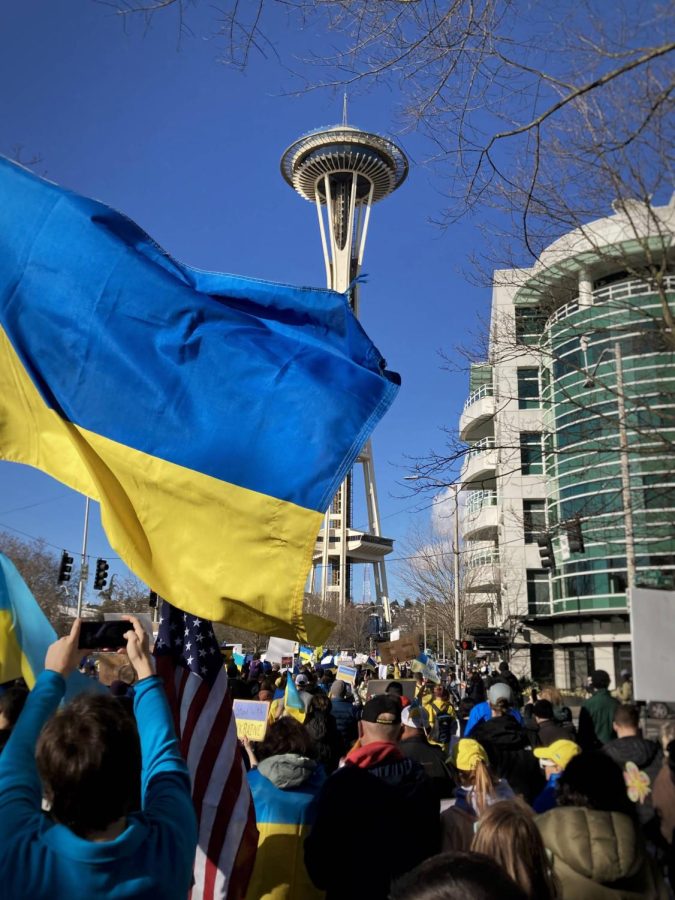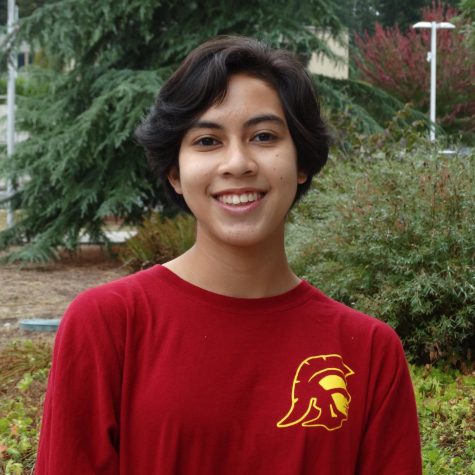Sunflowers and Solidarity: Seattle Stands with Ukraine
March 24, 2022
On March 5, at 1:30 p.m., on a rare sunny day, people clad in blues and yellows begin to trickle into the front plaza of Seattle City Hall and populate the grand staircase outside the building. We are so early that my parents are prematurely mourning the meager turnout, but I know from experience that 30 minutes from now, this stone monstrosity of a plaza will be bursting at the seams.
On a nearby bench, a couple chat animatedly, surrounded by bouquets of sunflowers. A quick Google search tells me that it’s the official flower of Ukraine. A few feet from us another teenager stands with a parent. Their yellow and blue striped shirt reminds me of a rugby jersey, and their head’s on a swivel, peering apprehensively in every direction. We make eye contact once; I give them a nod and receive a tentative smile in return. At the base of the staircase loiters a group of middle-aged individuals; one holds a full-sized Ukrainian flag that waves in the gentle breeze.
As the clock ticks down to 2:00 p.m., the official start time of the rally, more people flood into the square. They march in from all sides, a convoy of bright colors and makeshift signs. Two young women adorned with appropriately colored flower crowns hoist a sign over their heads that reads, “Close the sky over Ukraine.” It succinctly summarizes the driving force behind the gathering: to coerce the U.S. government into imposing a no-fly zone over Ukraine.
In the days following Russia’s invasion of Ukraine, thousands of people across the U.S. took to the streets to rally in support of Ukraine. In Seattle, there were several protests on Feb. 26, the Saturday after Russian troops breached the Ukrainian border. According to the New York Times, there were also major protests in Washington D.C., Chicago, Boston, Philadelphia, Phoenix—the list goes on. Many of the people who joined or organized rallies were Ukrainian Americans or Ukrainian immigrants, and while some protestors were sated by President Biden’s move to impose crippling economic sanctions on Russia, others urge the U.S. and NATO to take further action. This includes banning all Russian energy imports from the U.S., which Biden signed an executive order for on March 8, and enforcing a no-fly zone in Ukrainian area space. However, the reality of imposing a no-fly zone is this: the U.S. military would have to be ready and willing to shoot down Russian aircraft over Ukraine, which would draw the U.S. directly into the conflict and pit the two largest nuclear powers on the planet against each other.
The human cost of the Russian invasion may outweigh the risk of hostilities between Russia and the U.S., though, and the protesters here in the plaza certainly made a compelling demonstration for drastic action. A few minutes past 2:00 p.m., a woman with a bullhorn announced the plan: a speech will be given by an associate of the Ukrainian Association of Washington State, there will be a symbolic flash mob, and then, protestors will march one and a half miles through the streets of downtown Seattle to the Space Needle.
In the minutes before the speech, a heavy tension blanketed the air and settled deep in my heart, but despite the enormous weight of the circumstances that brought all these people here, an undeniable sense of community enveloped the crowd. Soon enough, a fiery Ukrainian woman stands on the balcony above the plaza, the bullhorn in hand. She highlights the strength of the Ukrainian people, but also their suffering, and pleads for the U.S. government to take action—to stand against Russia and the copious abuses they are committing in her homeland. She ends her speech with a few sentences in Ukrainian and a rousing chant of “Слава Україні,” meaning “Glory to Ukraine,” and the response, “Героям слава,” or “Glory to the heroes.” This chant has a long history as the war cry of Ukraine, but now, people across the globe know it. In a small plaza in the U.S., the words are echoed by hundreds of voices.
Then, the flash mob begins. The organizer gives people who don’t wish to participate a minute to clear out of the plaza. A drone hovers over the plaza, and then, the high-pitched shriek of an air raid siren cuts through the silence. It’s a discordant tone that strikes fear into the hearts of many, and a sound that I’ve yet to hear in real life. Everyone in the plaza looks skywards, gazing at the clear blue sky. Although not a single cloud pierces the blue canvas, my mind paints a gruesome picture of bombers slicing through the atmosphere. Helplessness grips me—the same icy terror that I imagine plagues Ukrainians at the sight of Russian soldiers in their streets. When the siren stops, everyone in the plaza is lying on the ground “dead”—representing the hundreds of Ukrainian civilians who have perished since February.
Once everyone has pulled themselves off the ground, we march. At the front, several people brandish a banner proclaiming the rally’s purpose. Others shoulder full-sized flags or raise spray-painted poster boards over their heads. An elementary school-aged child grips the handle of a hockey stick with a cardboard sign crudely duck-taped to the end. The crowd is so large that at each intersection, traffic halts for minutes at a time. There are sporadic chants of “No-fly zone!” in a hard-hitting rhythm. Occasionally, the same Ukrainian woman will cry “Glory to Ukraine” in the language, the fire in her voice resonating throughout the block, and dozens will reply in Ukrainian, “Glory to the heroes.”
When we finally reach the grand fountain at the base of the Space Needle, some march on while the rest of the crowd disperses. My family breaks off and watches the people stream past, protestors intertwining with perplexed tourists. This is one more instance of global solidarity with Ukraine—this sea of blue and yellow flowing through Seattle.



